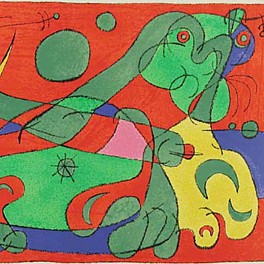BIOGRAPHY

1893 - 1983
Joan Miró is known for his playful art. His emblematic images make a naive, childlike impression at first sight. In contrast to the image of his art, he was a solid, hard-working man who preferred to come to gallery exhibitions in dark business suits.
Joan was born as the son of a goldsmith and jewelry maker in Barcelona in Northern Spain. He studied arts at the Barcelona School of Fine Arts and at the Academia Gali. His parents would rather have seen him taking a job as a serious businessman. He even took business classes in 1907 parallel to his art classes. Joan worked as an accountant for nearly two years until he had some kind of a nervous breakdown. His parents finally accepted their son's choice of a career as an artist without giving him too much support.
In the beginnings of his career he dabbled in different painting styles that were fashionable at the turn of the century like Fauvism and Cubism.
In 1920 Miró made the first of a series of trips to Paris. In 1921 he settled permanently in the French capital. He met Pablo Picasso and many of the other great painters and artists living in Paris - the center of arts in the late nineteenth and first half of the twentieth century.
From 1924 on, Miró joined the circle of the Surrealist theorist André Breton. His painting style took a turn to Surrealism. His comrades were André Masson and Max Ernst. But he never integrated himself completely into this group dominated by André Breton. He remained an outsider.
By 1930 the artist had developed his own style. Miró art is hard to describe. It is characterized by brilliant colors combined with simplified forms that remind viewers of drawings made by children at the age of five. Joan Miró art integrates elements of Catalan folk art.
In the 1930s the artist's fame and recognition became international. From 1940 to 1948 he was back in Spain. During this period he experimented in different media - sculpture, ceramics and murals.
In 1947, he came to the United States for the first time. He had several own-man shows. The most important one was a retrospective at the MoMA - The Museum of Modern Art in New York in 1951 and in 1959. In 1954 he won a prize at the Venice Biennale. In 1968 the artist finished a commission for two large ceramic murals at the UNESCO buildings in Paris.
Miró was a disciplined hard working man. He spoke little and looked like the perfect bourgeois. He was orderly, reliable and punctilious. Nothing in him had any touch of a bohemian.
He was also a modest man. In spite of international recognition, his financial situation was tense. He dreamed of a large studio where he could fulfill the numerous art projects and ideas that he collected in a little notebook. After World War II his time had finally come. His first trip to the USA pushed his popularity and the market value of his art work. And the modest little man pushed the galleries to give him a fairer share out of the sales. In a letter to gallery owners he wrote:
"What I will no longer accept is the mediocre life of a modest little gentleman."
In 1956 Miró could finally move into the villa of his dreams. Located in Palma de Majorca and built by the architect Josep Lluis Sert. The new home was built in an ultra-modern style typical for the avant-garde architecture of the fifties. In 1992 it was transformed into the Miró Museum open for the public.
